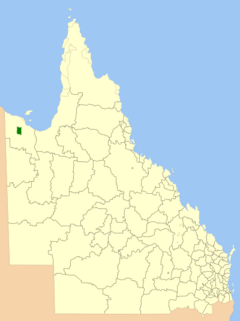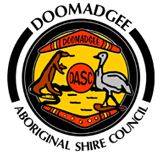Aboriginal Shire of Doomadgee facts for kids
Quick facts for kids Aboriginal Shire of DoomadgeeQueensland |
|
|---|---|

Location within Queensland
|
|
| Population | 1,387 (2021 census) |
| • Density | 0.7588/km2 (1.965/sq mi) |
| Established | 1987 |
| Area | 1,828 km2 (705.8 sq mi) |
| Mayor | Jason Grant Ned |
| Council seat | Doomadgee |
| Region | North West Queensland |
| State electorate(s) | Traeger |
| Federal Division(s) | Kennedy |
 |
|
| Website | Aboriginal Shire of Doomadgee |
The Aboriginal Shire of Doomadgee is a special local government area in North West Queensland, Australia. It is managed by the local Aboriginal community. This area operates under a special agreement called a Deed of Grant in Trust. This means the land is held in trust for the Aboriginal people who live there.
In 2021, about 1,387 people lived in the Aboriginal Shire of Doomadgee.
Contents
Where is Doomadgee Shire?
This shire is in a region called the Gulf Country. It is located south of the Gulf of Carpentaria. The shire has two separate parts. One part is the town of Doomadgee, which is inland. The other part is Gangalidda, which is on the coast. The entire shire is surrounded by the Shire of Burke.
History of Doomadgee
The name Doomadgee comes from "Dumaji". This is a coastal sand dune in the traditional land of the Yukulta / Ganggalidda people.
Traditional Languages
The Waanyi language is spoken in the Gulf Country. Its region includes parts of Lawn Hill Creek and the Nicholson River. It stretches from the border with the Northern Territory west towards Alexandria station. It also includes the Doomadgee area.
The Yukulta (also called Ganggalida) language is also from the Gulf Country. It is spoken in the Doomadgee area and the Shire of Mornington.
The Mission's Beginnings
"Old Doomadgee Mission" was started in 1933. It was set up by the Akehurst family, who were Christian Brethren. They had support from their church and the Queensland government. The mission's main goal was to provide a home for Gangalidda people. These people had been living on the edges of the Burketown town.
The first mission was at Dumaji, on Gangalidda land. In 1936, a cyclone destroyed the settlement. After this, the mission moved to the Nicholson River. This new location became known as "new Doomadgee".
Growth and Change
Doomadgee's population grew a lot in the 1950s and 1960s. More facilities were built for the community. These included a store, a bank, a post office, and a bakery. There was even a rodeo ground. In 1938, only 138 people lived there. By 2011, the population had grown to 1,257 people.
On March 30, 1985, the Doomadgee community elected five councillors. These councillors formed the Doomadgee Aboriginal Council. This council was set up to manage the community's affairs.
On May 21, 1987, the Aboriginal reserve land was officially given to the council. This was done under a Deed of Grant in Trust (DOGIT). The land included both the old and new mission sites.
On January 1, 2005, the Doomadgee Aboriginal Council became the Doomadgee Aboriginal Shire Council. This change meant it was now a formal local government.
Who Lives in Doomadgee?
Most people living in Doomadgee are Gangalidda or Waanyi. There are also smaller groups of Gadawa, Lardil, Mingginda, and Garawa people.
Leaders of Doomadgee
Here are the mayors who have led the Doomadgee Aboriginal Shire Council:
- 2008-2016: Frederick O'Keefe
- 2016-2020: Edric Walden
- 2020–present: Jason Grant Ned

